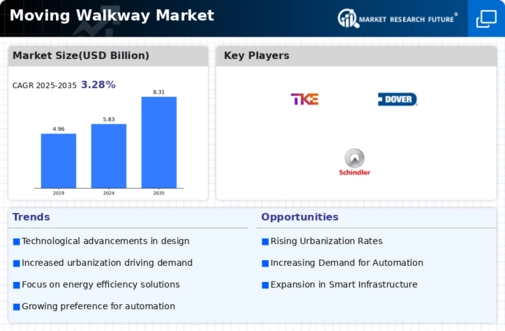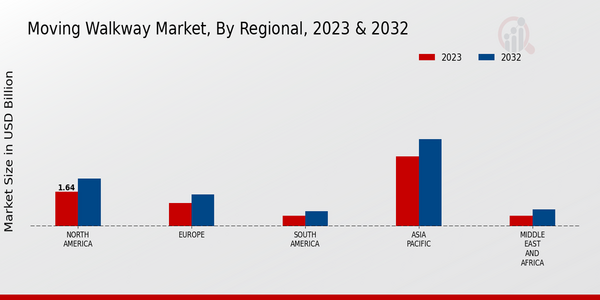Market Growth Projections
The Global Moving Walkway Market Industry is projected to experience substantial growth in the coming years. With a market value of 5.83 USD Billion anticipated in 2024, the industry is expected to expand significantly, reaching an estimated 8.31 USD Billion by 2035. This growth trajectory suggests a compound annual growth rate (CAGR) of 3.28% from 2025 to 2035. Such projections indicate a robust demand for moving walkways driven by urbanization, technological advancements, and increasing focus on accessibility. The market's expansion reflects broader trends in infrastructure development and the growing importance of efficient pedestrian transportation solutions.
Technological Advancements
Technological innovations in the design and functionality of moving walkways are likely to enhance their appeal in the Global Moving Walkway Market Industry. Advances such as energy-efficient motors, smart sensors, and enhanced safety features are transforming traditional moving walkways into more user-friendly and sustainable solutions. For example, the integration of IoT technology allows for real-time monitoring and maintenance, reducing downtime and improving user experience. These developments not only attract investment but also encourage adoption in various sectors, including airports and commercial buildings. As a result, the market is projected to grow at a CAGR of 3.28% from 2025 to 2035, reaching an estimated value of 8.31 USD Billion by 2035.
Increased Focus on Accessibility
The Global Moving Walkway Market Industry is increasingly influenced by a heightened focus on accessibility for individuals with mobility challenges. Governments and organizations are recognizing the importance of creating inclusive environments, leading to the installation of moving walkways in public spaces. This trend is particularly evident in transportation hubs, where moving walkways facilitate easier navigation for all users. For instance, airports are incorporating these systems to enhance passenger flow and minimize travel time between terminals. The growing emphasis on accessibility not only aligns with regulatory requirements but also promotes a more equitable society, thereby driving demand for moving walkways across various sectors.
Environmental Sustainability Initiatives
The Global Moving Walkway Market Industry is experiencing a shift towards environmentally sustainable solutions. As concerns about climate change and energy consumption grow, manufacturers are focusing on developing eco-friendly moving walkways. These systems often utilize energy-efficient technologies and sustainable materials, appealing to environmentally conscious consumers and businesses. For example, some manufacturers are exploring solar-powered moving walkways, which could significantly reduce energy costs and carbon footprints. This trend aligns with global sustainability initiatives, encouraging investment in green technologies and potentially expanding the market. As a result, the demand for sustainable moving walkways is expected to rise, further propelling market growth.
Expansion of Retail and Commercial Spaces
The expansion of retail and commercial spaces worldwide is a key driver for the Global Moving Walkway Market Industry. As shopping malls, airports, and exhibition centers grow in size, the need for efficient pedestrian movement becomes paramount. Moving walkways offer a practical solution to enhance the shopping experience and improve foot traffic flow. For instance, major retail chains are increasingly incorporating moving walkways in their flagship stores to facilitate customer movement and encourage longer visits. This trend is likely to boost the market, as the demand for moving walkways in commercial settings continues to rise, contributing to the overall growth of the industry.
Urbanization and Infrastructure Development
The rapid pace of urbanization globally drives the demand for efficient transportation solutions, including moving walkways. As cities expand, the need for infrastructure that facilitates smooth pedestrian movement becomes increasingly critical. The Global Moving Walkway Market Industry is poised to benefit from this trend, as urban planners and developers integrate moving walkways into public spaces, airports, and shopping centers. For instance, cities like Dubai and Singapore have adopted moving walkways in their transit systems, enhancing accessibility and reducing congestion. This trend is expected to contribute to the market's growth, with projections indicating a market value of 5.83 USD Billion in 2024.





